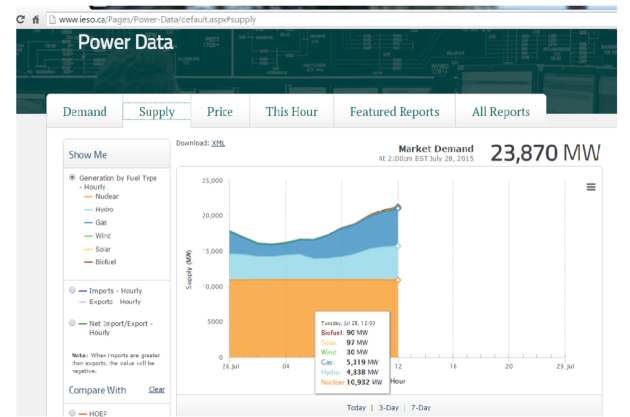July 28, 2015, was a great day for illustrating why the ‘R’ word – renewables – (wind and solar energy) should be used judiciously by thinking people.
First thing to note is that it was a hot day in Southern Ontario. Environment Canada issued a heat warning, forecast a high of 33°C, and recorded a temperature of 31°C at Pearson Airport at 1:00 PM.
On such a day, demand for electricity would have been at or near its annual peak as countless homes, businesses and public facilities cranked up their air conditioning.
The second thing to note is that the wind and solar generators that Ontarians have been forced to subsidize in vain pursuit of the provincial government’s green vision were effectively useless in terms of their contribution to meeting demand.
The Independent Electricity System Operator (IESO) manages the electrical grid in Ontario. The IESO reported that Ontario demand at 12:00 PM was 21,026 MW. The following screen shot taken from the IESO website indicates that at 12:00 PM wind generators were delivering 30 MW, and solar generators 97 MW, out of a total supply of 21,306 MW. Combined that’s just over ½ of 1%.
The chart also shows how so-called ‘dispatchable’ power sources, i.e., those that can be turned on and off or turned up and down in fairly short order, hydro and gas generation for example, were ramped up over the course of the day as the temperature, and demand for electricity, rose. It’s also evident that the nuclear fleet was providing the base load power needed day in and day out by the province, as it always does.
The installed capacity of wind is actually more than 3,000 MW but, on a hot, windless day, its effective capacity was about zero. Solar was operating pretty much at the peak of its capacity at midday; a fairly modest contribution however, despite there being acres of rooftops and farm fields covered with photovoltaic panels in Ontario.
All of this essentially useless and ineffective generating capacity costs ratepayers in the province billions of dollars and has contributed to Ontario’s declining industrial competitiveness. Anyone, and especially any politician, who suggests we need to move more quickly to renewables should be challenged on their facts and assumptions. Personally, I’m not keen on the prospect of freezing or frying in the dark because some misguided zealots are busy ‘saving the planet’ at my expense.
A few other points to note: gas plant capacity has increased in Ontario to offset the loss of retired coal-fired generating capacity and to provide back-up when it’s either too dark/cloudy, or too still for the renewables to deliver. So, Ontarians have had to pay twice for the effective capacity available.
Nuclear and hydro generation are greenhouse gas emissions-free and accounted for 86% of the electricity generated in Ontario in 2014 (62% for nukes, 24% for hydro). Few other jurisdictions on the planet can match that green hue.
Biofuel, another class of renewable, has also ramped up slightly. For the record, ‘biofuel’ in Ontario means burning wood. Yes, wood. It’s meant to be renewable because new trees will grow and replace those burned and will absorb the carbon dioxide emitted through combustion. That only takes 30-60 years, but hey, if we get to thump our chests and trumpet our green credentials then I guess it’s worth it. I can’t really think why else we’d be going back to wood to meet our energy needs.
Stay cool.


